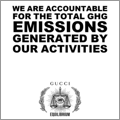Staying “positive”, yet avoiding greenwashing

Ecological awareness in the developed countries has never been greater than today, even if we are a lacking a general consensus. To describe their sustainable transition, brands are using in their communication the word positive and qualify through it lifestyle impact, carbon emissions, climate preservation and even nature protection. However, is simply declaring to be and do positive the right approach to avoid greenwashing?

Greenwashing is gaining momentum. The keyword on Google is reaching worldwide the same level as paraben, a major concern in cosmetics since the 2000s. The world is changing and brands are adapting. Some communicate on their environmental and social actions while others remain silent, because they are often lacking required skills. This is especially because sustainability has gained an engaged community since the concept was formalized in 1992 and there is a real fear of being publicly accused of greenwashing.
Greenwashing means misleading the audience about the ecological characteristics of a product and making it appear more ecological than it actually is. The tricky part about greenwashing is that it is not easy to avoid. Brands are lacking transparency and data across the entire value chain. Also, there can be a lack of holistic understanding on a topic as it is the case of plastic. Today, greenwashing is often done unintentionally, which makes it certainly even more dangerous.
When positive becomes greenwashing
Exaggeration is one of the most frequent cases when using the word positive becomes greenwashing: the t-shirts of a sustainable start-up that claims their t-shirts to be “earth positive” are still t-shirts. The start-up may have a serious approach to sustainability, but the claim “earth positive” can be considered as an overpromise to outperform the products of competitors.
The term “positive” is also often found in case of partial greenwashing, when a brand does not take the entire life cycle of a product into account. From raw materials to the end-of-life of a product, including transport, production, distribution and consumer use, no step can be forgotten, especially when a company seeks to achieve carbon neutrality. However, a lot of brands include only production and distribution in the calculation.
The term carbon positive goes even further as it means to offset more greenhouse gas emissions than are emitted.
Very advanced in the fight against greenwashing, Gucci sets an example with its Gucci Equilibrium program and takes into account the entire life cycle in the brand’s carbon accounting.
Finally, the word “nature positive” has strongly emerged since COP 15, held in Montreal, Canada at the end of 2022. The concept broadens the debate focusing on CO2 by adding a new chapter on biodiversity. Not clearly defined and not yet regulated, the term can easily become an example ofvague greenwashing. Marilia Monteiro Silva, Senior Portfolio Manager with Greenpeace International, calls out to take this concept off the discussion. She explains that it aims saving a dying economic model rather than truly protecting biodiversity, as it is impossible for humans to identically reside the nature they have previously destroyed.

Adopting a positive mindset without misusing the word positive
The concept of positivism and the related attribute “positive” is not chosen by hasard in the new ecological and social claims: it sends an enthusiastic image of life, joyful and forward-looking. A positive approach makes gloomy ecology appear outdated and it soothes eco-anxiety, an illness which appeared at the beginning of the 21st century and is a extreme worry about environmental disasters.
Furthermore, positivisme is key to trigger behavioral shift. Despite our growing ecological awareness, actions do not always follow. Several brain biases can actually prevent climate action: overconfidence biasis, resulting in a dangerous optimism about our ability to face challenges, to status quo basis, avoiding even positive change. Leveraging positivisme can help us overcome these biases. There are encouraging first results that demonstrate how gamification can encourage and accelerate behavioral shift.
Finally, positivisme can help us establish new codes to bridge what seems to be contradictory, the mandatories of transparency and sobriety of sustainability and certain emblematic codes of luxury. It will help us find a new vocabulary and fight more effectively against greenwashing. True to its tradition of excellence, luxury has a duty to set an example in this metamorphosis.
Visuel © Gucci Equilibrium, photos © Nacho Alegre © Rebekka Deubner
Wednesday 22 March 2023, 08:14










